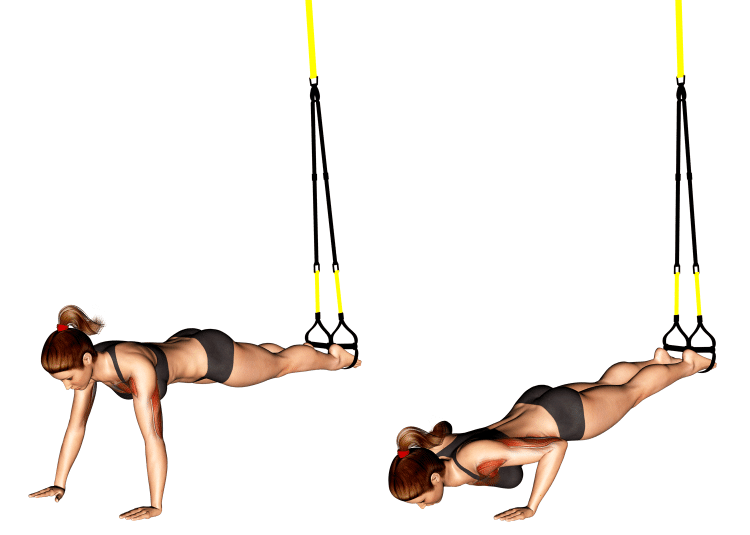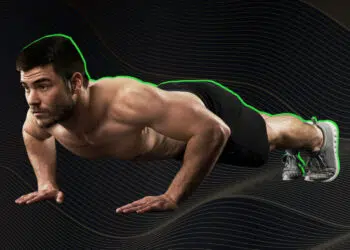Suspension push-ups are nothing new, but there are generally two ways to do them. Holding onto the handles with your upper body elevated which increases your range of motion, or feet lifted onto the straps several inches above the floor, enhancing the resistance, and your lower body engagement.
So which one is better?
The short answer, do both! After all, who does just one variation per muscle group? Training variety isn’t just beneficial because you can hit body parts from different angles. But who doesn’t eventually get bored of doing the same thing all the time? Another added benefit seldom talked about is that changing up your exercise has a mental element, and it’s also how we learn which movements feel better and give us a better muscle contraction, or motivation to train!
In this guide, you’ll learn the differences between both versions of suspension push-ups, although we’d like to get you more acquainted with the feet elevated technique. We’ll explain the unique benefits of suspension press ups, give you a cool chest and core torcher suspension combo technique, the best similar suspension push-up variations, and you’ll find answers to common faqs.
Muscles Worked During The Suspension Push-Up
Suspension push-ups will light the fuse and set off all the muscle fibers in your chest, front deltoids, and triceps.
Level Up Your Fitness: Join our 💪 strong community in Fitness Volt Newsletter. Get daily inspiration, expert-backed workouts, nutrition tips, the latest in strength sports, and the support you need to reach your goals. Subscribe for free!
Pectoralis major clavicular and sternal – The chest dominates among the “pushing” muscles which also includes the front deltoids and triceps muscles. It’s a larger body part composed of upper and bottom fibers that lift the arm forward and flex it downward, respectively.
Push-ups work the chest in its entirety, and because of the neutral position, likely more asymmetrically across both parts than decline or incline variations.
Deltoid anterior – If the pecs had ears, they’d be the anterior deltoids. Where the chest receives signals from presses, so do the front-facing shoulder muscles, or deltoid anterior.
Triceps brachii – Push-ups are an all-in one, compound exercise that recruits the chest, shoulders, and triceps muscles. Therefore, you can rest easy knowing your triceps are growing from your push day movements. A triple threat or three heads varying in size on the rear and side of the upper arm, triceps lengthen the arms via elbow extension.
Core – If you think suspension push-ups are just for the three aforementioned muscle groups, you’re sadly mistaken. Even moreso than a basic floor push-up, hanging the legs above the ground turns on the core muscles, such as rectus abdominis, deeper fibers, and obliques, so that they may stabilize the trunk, protect the lower back, and keep the torso straight for optimal energy transfer, and hence push efficiency.
How To Do The Suspension Push-Up
As with many exercises, there will be variances in technique from person to person. In the push-up, this can be hand position, width, and the height of the suspension straps. We can’t say there’s a perfect way to do it, however, safe movement mechanics, and optimal muscle stimulation are the most important aspects of any exercise.
Below you’ll find both written instructions detailing ideal press up techniques, along with a video demonstration of suspension push-ups.
Steps
- Hang your suspension straps roughly a foot off the ground. Although you can adjust it to a height of your liking, depending on how much resistance you need.
- Get down on all fours, with your hands open and palms flat on the floor spaced roughly shoulder width apart.
- Then extend one leg at a time behind you and place the top of your feet inside the suspension strap handles. Keeping your palms in line with your lower chest, straighten your elbows and prop up onto your arms, maintain a strong, neutral body position and engage your core muscles.
- Now push yourself all the way up while contracting your chest muscles.
- Lower your chest back down to the floor, and then knock out as many reps as you want to.
Here’s a very short video demonstration of suspension push-ups.
Pro Tips
- The higher you elevate your feet, the more resistance you’ll feel, hence making the exercise more challenging. However, a standard suspension push-up usually involves a smaller degree of feet elevation.
- Place a mat or cushioned object below your knees in case you need to drop down.
This Exercise
- Target muscle group: Chest
- Type: Hypertrophy
- Mechanics: Compound
- Equipment: Suspension straps/TRX
- Difficulty: Intermediate
Benefits of The Suspension Push-Up
There are unique benefits to using suspension straps when performing a push-up, including developing functional abs!
Build a silverback chest
While we’re not implying gorillas do push-ups to get such powerful, puffy pecs, suspension straps challenge your strength in a more natural way, challenging your innate abilities to keep your body strong, and transfer bodily force before delivering the press out. Therefore, you’ll be more equipped for functional activities.
Functional core
No mistake here, we really mean it. While suspension push-ups are not an ab exercise per se, your trunk muscles are engaged to keep your body in a strong, neutral position while protecting your lower back from hyperextension, and preventing body sagging. Which creates an unfavorable environment for optimal performance due to a discrepancy in energy distribution ability.
But wait… there’s another major benefit to the core by utilizing suspension straps. You can alternate push-ups with tuck crunches. So after you do one push-up, you’ll pull the knees in toward your chest to stimulate the lower section of abdominals, and help help bring out the sexy muscles near the groin area.
This is also called the atomic push-up and you can see a demonstration in the video clip shared below.
Perfect home workout alternative
Especially sweet for those who train outside of the gym or don’t have their own home setup. You can invest in a set of suspension straps, which are a tool that allow you to try so many different versions of exercise. It’s a genius invention different resistance bands, that uses your own bodyweight plus an unstable training environment for resistance, akin to free weight training.
Common Mistakes During The Suspension Push-Up
Adding the element of a suspension trainer increases the difficulty level of this exercise which means more room for error. These are things to not do for optimal performance and minimizing injury risk.
Saggy hips
Quite possibly the most mentioned push-up mistake. Although, if you are attempting suspension push-ups, we expect that you know how to do a proper push-up.
But anyhow, sagging your hips does several bad things when trying to attain the best chest gains possible.
If the hip sagging is excessive, your hips will touch the ground before your chest which will take the load off your chest during the eccentric phase and shift it onto the hips and stomach. This also causes energy leaks, redirecting effort toward supporting the poor hip positioning, reducing the effectiveness of the movement.
Moreover, you’ll increase stress on the shoulders, and not feel the movement as much in your chest.
Level Up Your Fitness: Join our 💪 strong community in Fitness Volt Newsletter. Get daily inspiration, expert-backed workouts, nutrition tips, the latest in strength sports, and the support you need to reach your goals. Subscribe for free!
That’s why you need to maintain a strong, neutral body position with the core engaged, to maximize your pressing power.
Aside from intentional sagging, the next common mistake can cause it if you don’t know what you’re doing…
Hanging the straps too high
Unless you want to target the deltoids or are more advanced, the straps should hang low enough that you can maintain proper chest focused push-up technique. You can watch the primary video demonstration under ‘how to do the suspension push-up’ to see an appropriate strap height. Then, you can adjust the straps little by little as needed.
Variations And Alternatives Of The Suspension Push-Up
Don’t have suspension straps? No problem. The first variation listed below solves that problem using anything you have available in your home. Then we’ll introduce you to more options similar to a more challenging push-up.
Suspension one leg push-up
If you feel comfortable and strong in the two legged suspension push-up, go ahead and take one foot out of the strap. You’ll have to engage your unilateral power to create the same movement without the help of your other half.
This simple form modification will make things a little shakier which is going to force you to engage more muscle and joint strength and stabilization.
Suspension incline push-up
This guide is all about the feet lifted suspension push-up, but you should also do the upper body elevated variation of suspension push-ups, also commonly called the TRX push-up. And it’s arguably the more popular version, as it actually challenges the chest, triceps, and delts more because it involves direct instability for the upper body, whereas the latter does this for the lower body.
The other biggie here is that you can include arm adduction motion which you can’t do with a standard floor press up.
Steps
- Adjust the height of your straps according to your experience level. The higher the straps, the easier the exercise while it’s harder the closer the handles are to the floor.
- Grip the handles then lean your full weight onto the straps with straight arms. Keep your body neutral, and tense the core, quads, and glute muscles for a strong body position for optimal strength transfer and preventing energy leaks.
- Lower your body toward the floor while moving the arms out, until you feel a little stretch in the chest.
- Now push through the handles to lift yourself up and bring your hands together to squeeze the chest muscles for a killer pec contraction!
Pro tip: The more upright you are, the less challenging the chest workout, and vice versa.
Suspension push-up with upper body elevated
While traditional push-ups are one of the greatest gifts life could give us, they also come with some drawbacks. Most notably that your range of motion is limited compared to almost every other chest exercise variation. But then again, you don’t need anything but your own body to do them, and you can do modified versions to make them more difficult.
If you want a better eccentric stretch in the chest, use two elevated objects like push-up bars or dumbbells to allow a greater range of motion. After all, research shows that the stretch part of an exercise is as important as the lift, or concentric phase, for inducing muscle gains (1).
For this movement, you’ll still elevate the feet, while incorporating two objects at the front end to get that nice stretch!
Steps
- Lift your feet up on the suspension straps.
- Grip onto two dumbbells, push-ups bars, or any two raised objects that allow you to drop the chest lower than the hands for a good stretch.
- Straighten your body, tighten your abs, pull your shoulders down and back.
- Bend your elbows and drop your chest down until your chest feels stretched.
- Push yourself all the way up.
Repeat these steps until you’ve achieved the desired number of reps.
Decline or Feet elevated push-ups (Bench, box, chair)
While suspended push-ups are also technically a feet elevated push-up, we’re referring to variations using more stable platforms like a chair, box, bench, etc. Whereas suspended describes a hanging, suspension strap version of the technique.
Feet elevated push-ups are more convenient, beginner-friendly, accessible, and arguably better for strength gains compared to it’s free-moving counterpart which is why we like it, especially for home workouts.
For example, if you want to elevate your feet high up in the air, it’s easier to do so with a sturdy object. Whereas suspension straps swing, and you have stick your feet in the straps, and take them out too. But both offer advantages.
Stability ball push-ups
A more convenient and typically affordable alternative to suspension strap push-ups, you can get one of those physio balls for press ups. They’ll challenge your balance, and force you to engage core power to avoid rolling over, while building your push muscles. Stability balls are no gimmick, they really are a useful training tool that you can use for a variety of exercises.
Pike push-up
You were always told to keep your body straight, and parallel to the floor when you do a push-up. Well the pike push-up breaks that rule. With the hips bent, and butt lifted high in the air, your body will resemble an inverted ‘V’ which allows you to shift your weight forward onto the arms and chest, in a more vertical movement pattern, allowing gravity to create a greater challenge for your target muscles. It’s slightly more delt centric but you’ll blast the upper pecs too!
Handstand push-up
In the boss level category of push-ups although still not the hardest, if you can flip your body upside down with your feet in the air, you’ll be using max bodyweight resistance, although it’ll be slightly more shoulder dominant. Still, you’ll activate lots of the upper chest, and you’re building the arm muscles which will carry over to your push day sessions.
Start with the wall assisted version of handstand push-ups, then if you’re interested in acrobatics, you’ll get more benefits with a free moving, non assisted handstand push-up.
Check out this complete guide to handstand push-ups.
Spiderman push-ups
Why did we choose spiderman push-ups as a similar alternative to the suspended version? Well, the latter creates instability, challenging your body more than a regular push-up. Without needing suspension straps, you can replicate an unstable movement by mimicking your friendly neighborhood superhero.
Atomic push-up
See the benefits of suspension push-ups section for this variation.
FAQ’s
What are the most effective set and rep ranges for suspension push-ups?
If you’re new to suspended push-ups, stick with 2-3 sets and don’t worry so much about the number of repetitions. Focus on using picture perfect form which is especially important for the push-up movement, in general.
When you get more experienced and confident in your stability push-up ability, then you can take your sets to failure, or performing as many reps as you can.
Are suspension push-ups better than decline push-ups?
Both are useful and equally beneficial but in their own way.
Suspension push-ups are more functional while decline push-ups offer better balance control, and are better for elevating the feet higher for a greater chest challenge.
What's the difference between a top end and bottom end suspension push-up?
The top end suspension push-up is the arguably more popular variation where your hands grip the handles, and the upper body is suspended in the air while your feet remain on the floor. This technique challenges the strength and stability of your chest, delts, and triceps, with a larger range of motion that includes more eccentric stretch on the pecs.
The bottom end version is the primary exercise in the training guide, where the feet are suspended by straps and the hands are on the floor. Not having the stability of your feet will challenge your core, lower body, and mental strength as you have to remain strong to push out at the top.
Wrapping Up
Okay, so you’ve tried the top end suspension push-up, now it’s time to tie up your feet (Not literally), and see how a simple technique change can shift the focus of gains. Which will come with its own list of benefits, and you’ll have a new, exciting technique to use for your chest training goals. If you have access to suspension straps, don’t let such a great movement go to waste that offers advantages over the more common upper body focused version of suspension push-ups where you grip the handles and performing a slight balancing act.
Interested in measuring your progress? Check out our strength standards for Push Ups, Floor Press, Incline Push Up, and more.









